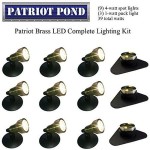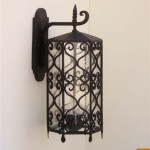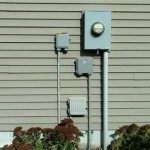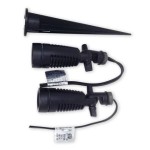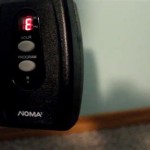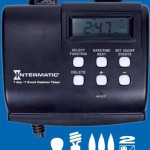Outdoor Flood Lights Wiring: A Comprehensive Guide
Outdoor flood lights are essential for security, illumination, and aesthetics. Whether you need to illuminate your driveway, highlight architectural features, or deter intruders, understanding the wiring process is crucial for a successful installation. This guide will provide a comprehensive overview of outdoor flood light wiring, covering everything from the basics to advanced considerations.
1. Choosing the Right Wiring
The first step in wiring outdoor flood lights is selecting the appropriate wiring. Consider the following factors:
- Voltage: Most outdoor flood lights operate on 120 volts (standard household voltage). However, some commercial-grade fixtures may utilize higher voltages. Check the manufacturer's specifications.
- Gauge: The thickness of the wire (gauge) determines its current carrying capacity. Thicker wire (lower gauge) is needed for higher wattage lights. A general rule of thumb is to use 12-gauge wire for up to 1,500 watts and 10-gauge wire for higher wattages. Use thicker wires for longer runs to minimize voltage drop.
- Wire Type: Outdoor applications require weather-resistant wire. Common options include:
- THHN: This wire is suitable for dry locations and is commonly used for in-wall wiring.
- UF-B: This wire is designed for underground or direct burial applications. It is highly resistant to moisture and abrasion.
- NM-B (Romex): This wire is also suited for in-wall wiring and can be used outdoors if protected by conduit or raceway.
2. Understanding the Wiring Diagram
Flood lights typically have four main wiring connections:
- Line (Hot): This wire carries the electrical current from the power source (circuit breaker) to the flood light.
- Neutral: This wire completes the electrical circuit and carries the current back to the power source.
- Ground: This wire provides a safe path for electrical current to flow in case of a fault. It is typically connected to the fixture's grounding terminal.
- Load (Switch Leg): This wire connects the flood light to the switch, allowing you to control the light's operation.
Refer to the flood light's installation instructions for a specific wiring diagram. This diagram will show the location of each terminal and how to connect the wires.
3. Installing the Flood Light
Once you've chosen the correct wiring and understood the wiring diagram, you can proceed with the installation:
- Plan the Location: Determine the best location for the flood light, considering coverage area, aesthetics, and ease of access. Make sure the location is free of any obstructions.
- Mount the Bracket: Most flood lights come with a pre-installed mounting bracket. Secure the bracket to the wall or structure using appropriate screws or anchors.
- Run the Wiring: Connect the wires to the flood light's terminal block according to the wiring diagram. Ensure proper polarity - black wire to black terminal, white wire to white terminal, and green wire to green terminal.
- Connect to the Power Source: Run the wires to the power source (circuit breaker) and connect them to the appropriate terminals. Use wire connectors to secure the connections.
- Test the Installation: Turn on the circuit breaker and switch on the flood light. Verify that the light is working properly and adjust the position if necessary.
- Secure the Wires: Use electrical tape or conduit to protect the wires from moisture and abrasion.
4. Safety Precautions
Electrical wiring can be dangerous if not handled properly. Always prioritize safety during the installation process:
- Turn off the Power: Before working on any wiring, disconnect power to the relevant circuit breaker.
- Use Appropriate Tools: Use insulated tools to avoid electrical shocks.
- Follow Electrical Codes: Familiarize yourself with local electrical codes and regulations to ensure a safe and compliant installation.
- Professional Assistance: If you are not comfortable working with electricity, seek professional assistance from a licensed electrician.
5. Advanced Wiring Considerations
For more complex installations or special requirements, you may consider the following:
- Motion Sensors: Use a motion sensor to automatically turn on the flood light when movement is detected, enhancing security and energy efficiency.
- Dimmers: Install a dimmer switch to adjust the light's brightness for different scenarios and moods.
- Timers: Use timers to set specific on/off times for the flood lights, providing security and convenience.
- Remote Control: Utilize a remote control to switch the flood light on and off from a distance, offering convenience and control.
Outdoor flood light wiring is a relatively straightforward task, especially when using a simple setup. However, remember to prioritize safety, choose the right wiring, and follow the manufacturer's instructions. By understanding the basics and taking necessary precautions, you can ensure a successful and reliable installation for your outdoor lighting needs.

Elegant Wiring Diagram Ceiling Light Diagrams Digramssample Diagramimages Wiringdiagramsam Outdoor Flood Lights Sensor Lighting Wire

70 Beautiful Flood Light Wiring Diagram Motion Sensor Lights Switch

How To Install Flood Lights

Electrical Wiring From A Photocell To An Outdoor Led Floodlight Or Reflector 110v Devices

How To Wire A Floodlight

Unique Wiring Diagram For Outdoor Motion Detector Light Diagrams Digramssample Diagramimage Flood Lights Sensor Lighting Wire

Led Flood Light Connection Diagram Circuit Info

How To Install Flood Lights

White Led Flood Lights Circuit

How To Install Outdoor Motion Activated Lights Tomcomknowshow
Related Posts
